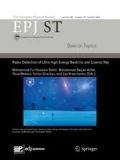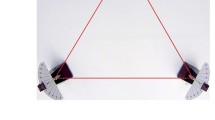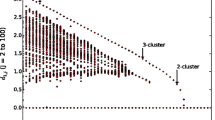Abstract
More than a decade ago, a surprising coexistence of synchronous and asynchronous behavior called the chimera state was discovered in networks of nonlocally coupled identical phase oscillators. In later years, chimeras were found to occur in a variety of theoretical and experimental studies of chemical and optical systems, as well as models of neuron dynamics. In this work, we study two coupled populations of pendulum-like elements represented by phase oscillators with a second derivative term multiplied by a mass parameter m and treat the first order derivative terms as dissipation with parameter ∊ > 0. We first present numerical evidence showing that chimeras do exist in this system for small mass values 0 < m ≪ 1. We then proceed to explain these states by reducing the coherent population to a single damped pendulum equation driven parametrically by oscillating averaged quantities related to the incoherent population.
Similar content being viewed by others
References
Y. Kuramoto, D. Battogtokh, Nonlin. Phen. Complex Sys. 5, 380 (2002)
D.M. Abrams, S.H. Strogatz, Phys. Rev. Lett. 93, 174102 (2004)
D.M. Abrams, R. Mirollo, S. Strogatz, D.A. Wiley, Phys. Rev. Lett. 101, 084103 (2008)
C.R. Laing, Phys. Rev. E 81, 066221 (2010)
C.R. Laing, K. Rajendran, I.G. Kevrekidis, Chaos 22, 013132 (2012)
I. Omelchenko, Y.L. Maistrenko, P. Hövel, E. Schöll, Phys. Rev. Lett. 106, 234102 (2011)
M.R. Tinsley, S. Nkomo, K. Showalter, Nat. Phys. 8, 662 (2012)
A.M. Hagerstrom, E. Thomas, R. Roy, P. Hövel, I. Omelchenko, E. Schöll, Nat. Phys. 8, 658 (2012)
N.C. Rattenborg, C.J. Amlaner, S.L. Lima, Neurosci. Biobehav. Rev. 24, 817 (2000)
C.G. Mathews, J.A. Lesku, S.L. Lima, C.J. Amlaner, Ethology 112, 286 (2006)
I. Omelchenko, O.E. Omel’chenko, P. Hövel, E. Schöll, Phys. Rev. Lett. 110, 224101 (2013)
J. Hizanidis, V.G. Kanas, A. Bezerianos, T. Bountis, Int. J. Bif. Chaos (accepted) (2014)
J.A. Acebron, L.L. Bonilla, C.J. Pérez Vicente, F. Ritort, R. Spigleri, Rev. Mod. Phys. 77, 138 (2005)
E.A. Martens, S. Thutupalli, A. Fourriére, O. Hallatschek, Proc. Natl. Acad. Sci. 110, 10563 (2013)
C.R. Laing, Chaos 19, 013113 (2009)
C.R. Laing, Chaos 22, 043104 (2012)
C.R. Laing (private communication)
Author information
Authors and Affiliations
Corresponding author
Rights and permissions
About this article
Cite this article
Bountis, T., Kanas, V.G., Hizanidis, J. et al. Chimera states in a two–population network of coupled pendulum–like elements. Eur. Phys. J. Spec. Top. 223, 721–728 (2014). https://doi.org/10.1140/epjst/e2014-02137-7
Received:
Revised:
Published:
Issue Date:
DOI: https://doi.org/10.1140/epjst/e2014-02137-7




